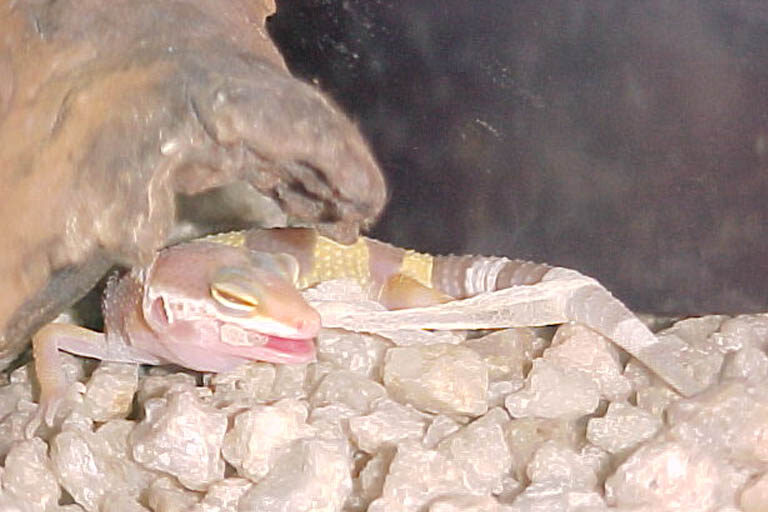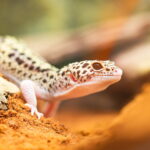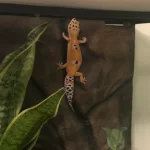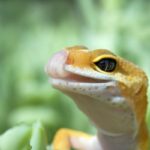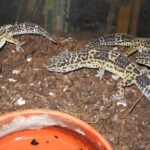Leopard geckos, like many other reptiles, shed their skin regularly as they grow. However, unlike most reptiles, leopard geckos engage in a unique behavior: they consume their shed skin. This process is scientifically referred to as ceratophagia, which translates to “horn eating” — a phenomenon where animals consume their sloughed-off skin or keratin-based structures.
While this behavior might seem unusual to us, it is actually common among geckos and serves several practical purposes. Other gecko species, such as the African fat-tailed gecko (Hemitheconyx caudicinctus) and the banded gecko (Coleonyx variegatus), also exhibit this behavior, along with a few other reptiles and some crustaceans.
For leopard geckos, skin consumption is a part of their natural routine and contributes to their survival in the wild.
Table of Contents
Shedding Process in Leopard Geckos
In healthy leopard geckos, the shedding process typically results in the old skin coming off in one large piece or a few substantial sections. These sections are often seen as being bitten and pulled off by the gecko itself, which then proceeds to chew and swallow them.
Shedding commonly occurs at night, a time when leopard geckos are most active. This nocturnal habit means that owners may rarely witness the shedding process firsthand, though small remnants of non-eaten skin may occasionally be found in their enclosure.
Leopard Geckos 101, an informative resource dedicated to leopard gecko care, encourages pet owners to understand these natural behaviors as a way to support and enhance the quality of life for these reptiles.
Why Do Leopard Geckos Eat Their Skin?
Despite the established fact that leopard geckos consume their skin, the specific reasons behind this behavior are not fully understood. However, there are a few widely accepted theories that can shed light on why this unusual habit may have developed.
Regaining Lost Nutrients
One of the primary reasons that experts believe leopard geckos eat their skin is to reclaim lost nutrients. Living in dry, arid environments, leopard geckos often face nutrient scarcity, especially when it comes to essential minerals. When they shed, the discarded skin contains valuable minerals and nutrients that would otherwise go to waste.
By consuming their skin, leopard geckos “recycle” these nutrients back into their bodies, maximizing the resources available to them. Additionally, the skin may contain small amounts of re-usable energy, which can be helpful in resource-limited environments.
Concealing Their Territory from Predators
Another theory suggests that leopard geckos eat their skin as a means of concealing their presence from predators. In the wild, any leftover skin could serve as a potential clue to predators, signaling a recent gecko presence and potentially leading to a closer investigation of the area.
By consuming their shed skin, leopard geckos effectively erase evidence of their presence, making it harder for predators to track them. This behavior could also reduce competition with other geckos by eliminating traces that might attract unwanted attention from rivals.
Assisting the Shedding Process
Beyond reclaiming nutrients and concealing their presence, the act of consuming shed skin may also aid in the shedding process itself. When leopard geckos bite and pull at their loose skin, they help to hasten the process, reducing the likelihood of skin retention.
Retained skin can be problematic for geckos, as it may constrict parts of their body, leading to restricted blood flow and, in severe cases, loss of toes or other extremities. By removing and eating their skin, geckos prevent these potential complications, ensuring a clean shed and maintaining their overall health.
Potential Risks of Retained Skin
Retained skin is a significant concern for leopard geckos, as it can lead to health issues if not properly managed. For instance, when skin remains stuck to toes or other parts of the body, it can cause constriction, which restricts blood flow and may ultimately result in the loss of the affected area.
This complication is especially dangerous in regions such as the toes, tail, or limbs, where circulation is already limited. Retained skin can also increase the likelihood of infections, which can spread rapidly and become life-threatening if left untreated.
In cases where a gecko struggles with shedding, the assistance of a qualified reptile veterinarian or knowledgeable pet owner may be required. Proper humidity levels, a suitable enclosure, and gentle handling during shedding periods can help minimize the risks associated with retained skin.
Nutrient Recycling: An Evolutionary Advantage
From an evolutionary perspective, nutrient recycling through skin consumption offers distinct advantages for leopard geckos. Unlike animals that rely on abundant resources in their environment, leopard geckos are adapted to survive in conditions where food and water may be limited.
The act of consuming their own skin allows them to make the most of every available nutrient, which can be particularly valuable during times of scarcity.
Studies have shown that the skin of leopard geckos contains trace amounts of essential minerals, such as calcium and potassium, which play a vital role in their physiological functions. Calcium, for example, is essential for bone health and muscle function, while potassium helps to regulate cellular processes.
By consuming their skin, leopard geckos can replenish some of these critical nutrients, reducing the need to source them externally.
The Role of Skin Eating in Leopard Gecko Habitat Management
In addition to nutrient recycling, skin eating also serves a practical purpose in the gecko’s habitat. By consuming shed skin, leopard geckos maintain a cleaner environment, reducing the presence of waste and potential odors that might attract predators.
This behavior, therefore, not only serves as a self-preservation mechanism but also helps leopard geckos establish and maintain a safe and concealed habitat.
In captivity, this behavior is equally beneficial, as it reduces the amount of maintenance required by pet owners. However, it’s essential to monitor captive geckos during their shedding process to ensure that any remaining skin is safely removed, particularly if the gecko appears to be struggling.
Shedding Frequency and Health Considerations
The frequency of skin shedding in leopard geckos varies based on their age, health, and environmental conditions. Young geckos, which are growing rapidly, may shed as frequently as once every few weeks, while adult geckos typically shed every four to eight weeks. Factors such as humidity, temperature, and nutrition all play a role in the ease and frequency of shedding.
Ensuring that a leopard gecko enclosure has the appropriate humidity level can significantly impact the shedding process. Low humidity levels may cause the skin to dry out too quickly, making it harder for the gecko to shed smoothly. In such cases, providing a humid hide or misting the enclosure can help support a healthy shedding cycle.
Addressing Skin Shedding Issues
While most leopard geckos shed their skin without any problems, some individuals may experience difficulties, especially if they are kept in conditions that don’t closely mimic their natural habitat. A lack of adequate humidity or access to rough surfaces within the enclosure may make it harder for geckos to shed completely.
For pet owners, providing a well-maintained and adequately humidified environment is essential. Leopard geckos benefit from having a “humid hide” — a small, enclosed area with higher humidity where they can retreat during shedding. This setup mimics the natural conditions they might seek out in the wild, helping them shed more effectively.
Conclusion- Understanding Leopard Geckos Skin Eating Behavior
In conclusion, the behavior of eating shed skin is a natural and beneficial process for leopard geckos. Although we don’t have all the answers to why they engage in this behavior, several plausible explanations exist.
By consuming their shed skin, leopard geckos likely regain valuable nutrients, avoid detection by predators, and aid in the shedding process itself, which helps maintain their health.
For leopard gecko owners, understanding this behavior is crucial to providing optimal care. Knowing that skin consumption is a natural part of their biology can help prevent unnecessary worry and enhance the way owners manage their pet’s enclosure and environment.
Leopard geckos are fascinating creatures with unique behaviors, and respecting these natural processes can lead to a more enriching and fulfilling experience for both the pet and the owner.

